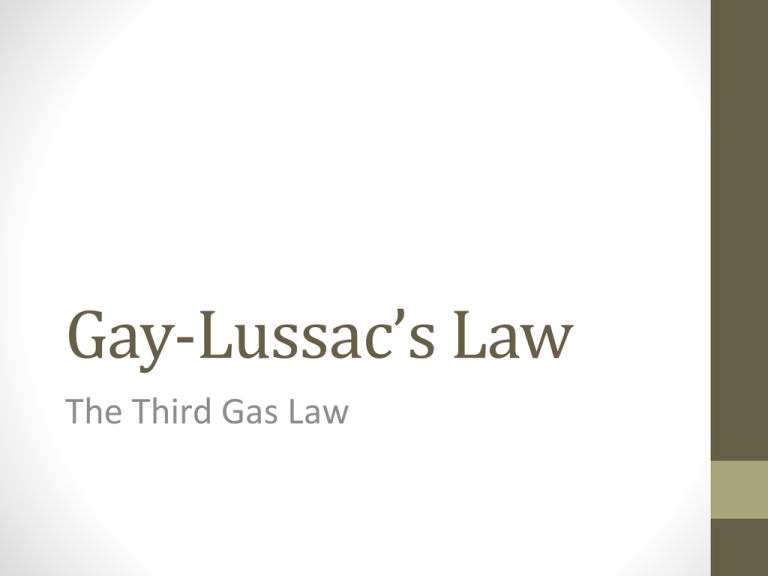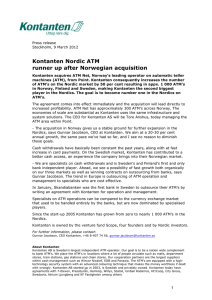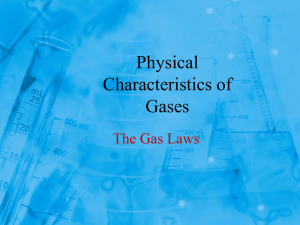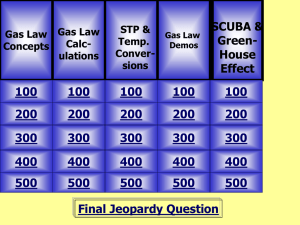
Gay-Lussac’s Law
The Third Gas Law
Objectives
• When you complete this presentation, you
will be able to
• state Gay-Lussac’s Law in terms of pressure
and temperature
• use Gay-Lussac’s Law to calculate pressure and
temperature values when a gas is kept at a
constant volume.
Introduction
• This law was not discovered by Joseph Louis
Gay-Lussac.
• He was actually working on measurements
related to Charles’s Law.
• This relationship between pressure and
temperature was actually discovered by
another French chemist, Guillaume
Amontons in about 1702.
• However, it is still called Gay-Lussac’s Law.
Introduction
• Amontons noticed that there was a
relationship between the pressure of a gas
and the temperature of that gas when
volume was held constant.
• He noticed that pressure and temperature
were directly related.
• As the temperature increased, the pressure
increased.
• As the temperature decreased, the pressure
decreased.
Introduction
• This behavior would be expected from the
assumptions of the kinetic theory.
• As the temperature increases, the average
speed of the gas particles also increases.
• This causes the collisions with the walls of the
container to be more forceful.
• More force over the same area (remember,
volume is constant) gives more pressure.
Application
• We can write Gay-Lussac’s law two different
ways:
• P/T = k or P = kT, where "k" is a constant.
• P1/T1 = P2/T2
• We most often use the second notation to
solve problems.
Application
• When we are trying to solve a Gay-Lussac’s
law problem, we will need to know three of
the four variables.
• For P1/T1 = P2/T2 we can solve for:
• P1 = P2(T1/T2)
• T1 = T2(P1/P2)
• P2 = P1(T2/T1)
• T2 = T1(P2/P1)
Example 1 – Finding P2
A 3.00 L flask of oxygen gas has a pressure of 1.15 atm at a
temperature of 308 K. What is the pressure when the
temperature is raised to 373 K?
P1 = 1.15 atm
T1 = 308 K
P2 = ? atm
T2 = 373 K
P2 = P1(T2/T1) = (1.15 atm)[(373 K)/(308 K)] = 1.39 atm
Practice Problems – Finding P2
1. A sample of nitrogen gas has a pressure of 1.00 atm at
a temperature of 298 K. What is the pressure at 350 K?
1.17 atm
2. A sample of hydrogen gas has a pressure of 0.450 atm
at 350 K. What is the pressure at 600 K?
0.771 atm
3. A flask of oxygen gas has a pressure of 25.0 atm at 650
K. What is the pressure at 250 K?
10.4 atm
4. A tank of neon gas has a pressure of 0.125 atm at 250
K. What is the pressure at 750 K?
0.375 atm
Example 2 – Finding P1
A tank was pumped full of air at a temperature of 313 K.
What was the original pressure if the pressure in the tank
is 260 kPa when the temperature is lowered to 263 K?
P1 = ? kPa
T1 = 313K
P2 = 260 kPa
T2 = 263 K
P1 = P2(T1/T2) = (260 kPA)[(313 K)/(263 K)] = 309 kPa
Practice Problems – Finding P1
1. A flask of nitrogen gas has a pressure of 2.50 atm at
350 K. What was the pressure at 250 K?
1.79 atm
2. A sample of hydrogen gas has a pressure of 32.4 kPa at
400 K. What was the pressure at 600 K?
48.6 kPa
3. A flask of neon gas has a pressure of 143 mm Hg at 125
K. What was the pressure at 298 K?
341 mm Hg
4. A tank of argon gas has a pressure of 245 atm at 300 K.
What was the pressure at 350 K?
286 atm
Example 3 – Finding T2
A gas collecting tube held hydrogen gas at 0.995 atm and
298 K. What is the temperature of the gas if the pressure in
the tube is 0.845 atm?
P1 = 0.995 atm
T1 = 298 K
P2 = 0.845 atm
V2 = ? K
T2 = T1(P2/P1) = (298 K)[(0.845 atm)/(0.995 atm)] = 253 K
Practice Problems – Finding T2
1. A xenon gas sample had a pressure of 0.972 atm at 298
K. What is the temperature at 4.50 atm?
1,380 K
2. A sample of helium gas had a pressure of 322 kPa at
310 K. What is the temperature at 154 kPa?
148 K
3. A flask of chlorine gas had a pressure of 847 mm Hg at
432 K. What is the temperature at 760 mm Hg?
387 K
4. A tank of radon gas had a pressure of 4.25 atm at 301
K. What is the temperature at 4.75 atm?
334 K
Example 4 – Finding T1
A tank held nitrogen gas at 784 mm Hg . When the
temperature of the flask is set at 330 K, the pressure is
642 mm Hg. What was the initial temperature of the tank?
P1 = 784 mm Hg
T1 = ? K
P2 = 642 mm Hg
T2 = 330 K
T1 = T2(P1/P2) = (330 K)[(784 mm Hg)/(642 mmHg)]= 1.39 atm
Practice Problems – Finding T1
1. A carbon dioxide gas sample has a pressure of 1.25 atm
at 298 K. What was the temperature at 1.00 atm?
238 K
2. A sample of fluorine gas has a pressure of 98.3 kPa at
310 K. What was the temperature at 85.3 kPa?
269 K
3. A flask of chlorine gas has a pressure of 675 mm Hg at
425 K. What was the temperature at 473 mm Hg?
298 K
4. A tank of air has a pressure of 240 atm at 301 K. What
was the temperature at 250 atm?
314 K
Summary
• Gay-Lussac’s Law:
• At a constant volume,
• the pressure of a gas is directly proportional
to its temperature.
• Equations:
• P/T = k or P = kT, where k is a constant
• P1/T1 = P2/T2








